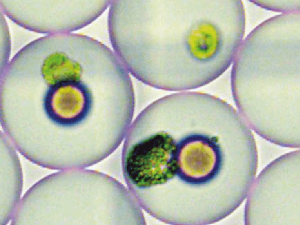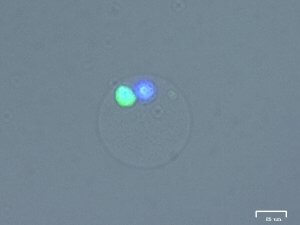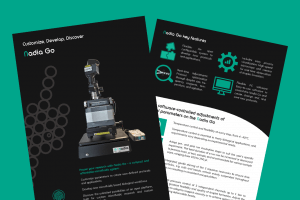History of microfluidics

A plethora of biological techniques have been developed in the past decade which allows the study of a large cell population. These techniques reveal a cellular heterogeneity that exists among different tissues or the same type of cells.
This can lead to variations in cell size, functions, biological activity, and when it comes to cancer cells, a different drug response. Thus, microfluidics is a promising tool for single-cell research in order to reveal cellular heterogeneity.
Single-cell research has many applications, the analysis of individual transcriptomes also called single-cell RNA Seq (scRNA-Seq), being one of the popular ones. Most commercial platforms employ microfluidic techniques to achieve high sample throughout. For instance, scRNA-Seq on such platforms involves the capture of single cells in microfluidic droplets along with barcoded mRNA capture beads. Commercially available instruments tend to focus on commonly used cell types, i.e. mammalian cell types, with predefined consumables and protocols.
So, why is customization important?
Cells obtained from plants or other less typical cell types may require protocol adjustments of the single-cell capture step. This is due to variability in cell size, buffer compositions and other variations.
A versatile open system is then required in order to successfully apply the capabilities of single-cell research to non-mammalian organisms. Additionally, scientists working on canonical cell types may also wish to develop new protocols to fit their specific experimental needs. In this case flexible technology would also be of value.
Applications and cell types
A flexible microfluidic system opens up a wide range of applications:
scRNA-Seq of plant leaf protoplasts

Plant leaf cells can be large (approximately 60 μm) and they require storage in high viscous and high osmolarity buffers to avoid premature lysis. Thus, to proceed with cell sequencing, it is essential to alter the pressure levels and on-chip stirring speed to generate droplets.
Read about research previously completed by Dr Aki Minoda using plant cells with the Nadia Innovate here.
Improving mRNA capture for small cells/organelles
Some cell types such as nuclei and exosomes which are less transcriptionally active may require several adjustments to improve mRNA quality before sequencing. In a case study, Davey et al. used the Nadia Innovate to increase oil pressure to reduce droplet size. Then, by reducing droplet size from 85 μm to 65 μm, the reaction volume was halved. Consequently, mRNA concentration was increased and resulted in better library capture.
Lysis strength optimization
Nuclei and organelles can be harder to crack than other cell types. Therefore, lack of complete lysis using commercially available buffers can affect single-cell studies and subsequently the genomic data that will be obtained. Thus, customization is important to alter pressure levels to accommodate lysis buffer viscosity. Additionally, a heated lysis step can improve lysis efficiency and also improve library yield when used for single-nucleus RNA Sequencing.
Agarose encapsulation for cell growth

Encapsulating single cells in hydrogel droplets is the first step in many downstream workflows used for cell-cell or cell-pathogen interaction studies or FACS of single-cell microenvironments using flow cytometry.
An increase in both oil and agarose pressure will be essential to deal with the high viscosity of agarose. Afterwards, produced droplets can be cooled and separated from the oil phase to produce hydrogel spheres containing single cells. Another example of using the temperature feature would be the use of collagen-based gels that will cool the Nadia Go chip instead of heating it.
How to customize single-cell research
There are four parameters that can be adjusted during droplet formation to suit a specific single-cell application.

On our new Nadia Go instrument, researchers can customize a wide range of interchangeable parameters and optimize their single-cell research. These parameters (Figure 1) can be adjusted during droplet formation to suit a specific application.
Temperature
Temperature control is essential in many biological applications, and requirements can vary depending on experimental needs. For instance, cold temperature helps maintain cellular transcriptome state while heating is required to enable the production of agarose-based hydrogel beads by keeping the agarose molten.
Stirring speed
Preventing cells and beads from settling is essential to reduce the probability of encapsulating two cells or two beads together (doublet rate) throughout a run. Stirring speed can be controlled individually and is used to keep beads and cells evenly in suspension to achieve optimal results.
Time
Timing is an important component in many biological applications. Different biological applications require different incubation times. Changes in pre- and post-run incubation steps can be created to suit the user’s specific experiment. Furthermore the total duration can be decreased to seconds or increased to hours and accommodate various sample sizes, ranging from 100 to 250 μl.
Pressure
Using a positive pressure can be beneficial to push liquids into microfluidic channels and generate droplets. At a set pressure, fluids of different viscosities travel at different speeds and this influences droplet formation. Cells like plant protoplasts, where standard buffers such as PBS is not recommended would require the user to adjust pressures to achieve stable droplet formation. Additionally, changing pressures also enables researchers to alter the droplet diameter to suit a variety of cell sizes.
Get started with the new Nadia Go guide
Developing a whole new protocol from scratch can be challenging, especially when the user is not familiar with the basic principles of microfluidics. To help make this easier and available to all biologists Dolomite Bio created a ‘Get Started’ guide that walks researchers easily through every stage of protocol optimization. This new document includes a workflow that guides the user in a step-wise manner through protocol development and single cell customization.
Interested in single cell RNA-Sequencing and single nuclei RNA-Sequencing using human or mouse cells? Learn more about the Nadia products here!


Learn more about customization
Customizing single cell research protocols with Nadia Innovate

